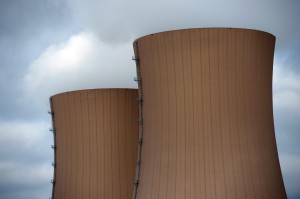High-Level Nuclear Waste Could One Day Come to Texas, But It’s a Long Road

Frank Map DPA/Landov
Cooling towers of a nuclear power plant in Grohnde, Germany. An interim charge for the Texas legislature could change the United States' management of nuclear waste.
The United States’ total high-level radioactive waste could fit inside a football stadium with room to spare. Right now, it’s distributed between the country’s 100 commercial nuclear power plants and stored on site. But all that waste could be headed to Texas in the coming years.
One of Texas House Speaker Joe Straus’ interim charges for the 83rd legislature (basically study material that could come in handy during the next session when it comes time to file legislation) has exactly that goal in mind.
The charge, addressed to the House Committee on Environmental Regulation, says to “make specific recommendations on the state and federal actions necessary to permit a high-level radioactive waste disposal or interim storage facility in Texas.” While Texas already allows low-level radioactive waste storage, this new suggestion has drawn its fair share of controversy, intrigue and confusion. So let’s take a look at the ins and outs of nuclear waste storage, and how it could pan out in the Lone Star State.
What is High-Level Radioactive Waste Exactly?
Simply put, high-level radioactive waste is spent fuel from commercial nuclear power plants. It has a much longer half-life and is far more concentrated than low-level waste—medical equipment or contaminated clothes and tools used in nuclear power plants, for example—so it needs to be handled in a very careful, specific way.
“Whenever you’re giving off radiation, that radiation will deposit somewhere and create a little bit of heat. If you are producing heat, you have to remove the heat,” Steven Biegalski, Director of the Nuclear Engineering Teaching Laboratory at the University of Texas, says. “If you don’t remove even just a little bit of heat, temperatures can rise and then there’s issues. It’s not that these issues are insurmountable … when you’re doing it, you’re looking at thousands and thousands of years for the time we would expect things to be contained in a high-level waste repository.”
One widely-accepted solution for dealing with the waste involves burying it deep underground or recyling it—but putting it on a rocket and sending it into the sun has also been tossed around.
The directive from Straus asks the legislature to look into two types of high-level radioactive waste storage in Texas: a central interim storage site and a permanent, long-term national repository.
“The big fear we have about a long-term storage is that a private company will come in, make all the gain, and leave Texas with all the pain of having to maintain this site for millennia,” Tom “Smitty” Smith, director of Public Citizen’s Texas office, says.
Why Texas and Why Now?
An ideal site for storing high-level radioactive waste, according to Biegalski, would need to be dry, geologically stable, and away from dense population centers, making areas like western Texas and much of Nevada perfect candidates. But there is currently no plan for a national repository.
In 2002, Congress approved a site within Yucca Mountain, in Nevada, to be a long-term storage site, but the Obama Administration ended funding for the site in 2010 after years of pressure from state officials and Senate Majority Leader Harry Reid. There was no backup plan, yet nuclear power plants have still been paying a tax to fund a permanent storage site.
According to Dale Klein, Associate Director of the University of Texas at Austin’s Energy Institute and former Chairman of the U.S. Nuclear Regulatory Commission, utility companies have put almost 30 billion dollars into that fund since 1982. Though companies are still paying—and passing the costs off to consumers—recent lawsuits have challenged the legality of collecting money without having a proposed site.
“The courts have recently ruled that the Department of Energy cannot continue to charge [the tax] because they have no plan,” Klein said. “It hasn’t been finalized, but the courts directed the Department of Energy not to collect that fee anymore.”
Taxes aside, power plants can safely store their high-level radioactive waste on-site for the time being, in pools and steel casks. Klein estimated that this is viable and safe for about another 100 to 200 years. But many states don’t want that waste in their own backyards and are willing to pay for someone else to take care of it.
“They technically can handle it on site, and it’s not so difficult that it has prevented utilities from making decisions to build new nuclear power plants,” Biegalski says, “But on some level it’s frustrating that this problem is being kicked down the road when the U.S. government said they’d tackle the problem and that they’d solve it, but yet they’re not.”
This is where Texas could step in.
Why is it So Controversial?
Approving an interim storage facility for high-level radioactive waste would be relatively painless, Klein says, but a national repository to bury it underground for tens of thousands of years will take much longer and be far more controversial.
“In general, what will happen is that the public will probably not get as emotionally engaged on a central interim storage, because that’s a temporary process. But the permanent geological storage is one that typically brings out a lot of emotions,” he says.
Klein put the likelihood of central interim storage in Texas as high, while a permanent repository isn’t as likely.
The directive for the legislature to study the issue may have been influenced by private Texas companies looking to take economic advantage of a national problem. Waste Control Specialists owns a treatment, storage and disposal facility for low-level radioactive waste in Andrews, Texas, and could be a top bidder to manage any incoming high-level waste.
But awarding them a contract for the disposal would be a huge mistake, Smith of Public Citizen says.
“It’s all risk and very little reward for the state of Texas. High-level radioactive waste is extremely dangerous and has been rejected by every state that has looked at it because of the high likelihood that if it comes in contact with water or other chemicals, you could have an out-of-control reaction,” he says.
“The current low-level radioactive waste site is adjacent to an aquifer that serves eight states, and there is water in the monitoring wells around the storage and disposal facilities, which we can’t get dry after years of pumping.”
Smith acknowledges, however, that there could be sites in Texas or other states suitable for a national repository, but they haven’t been evaluated yet.
“There may well be some other sites that are better for long-term waste than Texas, and that’s a decision that should be made, based on science, at the national level, rather than made by a a committee in the Texas legislature,” he says.


